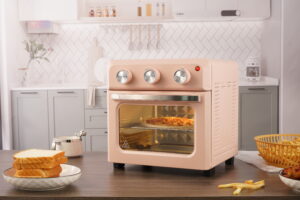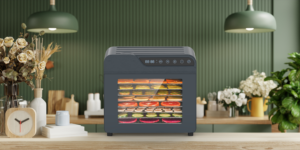As the Sales Manager at Foshan Linden Intelligent Appliances Co., Ltd., I’m passionate about helping home cooks make healthier, tastier meals. From our factory in China, we produce top-quality 12L, 16L, and 30L air fryer ovens, air fryers, and food dehydrators, exported to North America, Europe, Russia, and the Middle East. A question I often hear at trade shows and through our website, lindensmart.com, is: Which cooking method retains more nutrients—air fryer ovens or traditional oven roasting? I’m excited to share my expertise and dive into this comparison to help you choose the best method for nutritious cooking.
In this article, I’ll explore air fryer ovens and oven roasting, focusing on their impact on nutrient retention, flavor, and overall convenience. Drawing from our experience at Linden, where we design innovative appliances with customizable settings, I’ll break down the pros and cons to guide your decision. Let’s discover which method keeps your food packed with nutrients!
Understanding Air Fryer Ovens and Oven Roasting
Both air fryer ovens and traditional oven roasting are popular cooking methods. They use heat to prepare food, but their approaches differ, affecting nutrient retention, taste, and texture. Understanding these differences is key to choosing the best method for healthy meals.
What Is an Air Fryer Oven?
Air fryer ovens are versatile countertop appliances. They use rapid air circulation to cook food, delivering crispy results with minimal oil. At Linden, our air fryer ovens combine frying, baking, roasting, grilling, and dehydrating, making them a go-to for healthy cooking.
What Is Oven Roasting?
Oven roasting involves cooking food in a conventional oven using dry heat. It’s ideal for large cuts of meat, vegetables, or casseroles, often at high temperatures (350–450°F). Traditional ovens are a kitchen staple but differ from air fryer ovens in cooking speed and nutrient preservation.
Why Compare Nutrient Retention?
I’ve seen health-conscious cooks prioritize methods that preserve vitamins and minerals. Comparing air fryer ovens and oven roasting helps you choose the appliance or technique that maximizes nutrition while fitting your busy lifestyle.
How Air Fryer Ovens Work
Our air fryer ovens use high-speed air circulation to cook food. A powerful fan and heating element create a hot air vortex, cooking food evenly and quickly. According to Healthline, air frying reduces fat by up to 85%, making it a healthier alternative to traditional frying. Our 16L model, for instance, can roast vegetables or chicken with precision, retaining nutrients effectively.
Key Features of Air Fryer Ovens
- Fast Cooking: Prepares meals in 10–25 minutes.
- Low Oil Use: Promotes healthier, nutrient-rich meals.
- Versatile Functions: Fries, bakes, roasts, grills, and dehydrates.
- Precise Controls: Adjustable settings for optimal nutrient retention.
How Oven Roasting Works
Oven roasting uses dry heat in a conventional oven to cook food. It relies on radiant heat from the oven’s walls and elements, often requiring longer cooking times. While effective for large dishes, roasting can impact nutrient levels, especially in vegetables, due to prolonged heat exposure.
Key Features of Oven Roasting
- Even Cooking: Ideal for large roasts or trays of food.
- High Capacity: Suits big meals or batch cooking.
- Flexible Temperatures: Handles a wide range of recipes.
- Traditional Method: Familiar to most home cooks.
Comparing Nutrient Retention
Nutrient retention is a top concern for health-focused cooks. Let’s compare how air fryer ovens and oven roasting affect the vitamins and minerals in your food, particularly vegetables, meats, and fruits.
Air Fryer Ovens: Superior Nutrient Preservation
Our air fryer ovens excel at retaining nutrients due to their fast cooking times and lower oil use. Shorter exposure to heat preserves heat-sensitive nutrients like vitamin C and B vitamins, as noted by WebMD. For example, air frying broccoli in our 12L model takes 10–12 minutes at 360°F, minimizing nutrient loss compared to longer roasting.
Nutrient Retention in Vegetables
Vegetables like zucchini or carrots retain more vitamins when air fried. The rapid air circulation cooks them quickly, preserving antioxidants and water-soluble nutrients, per Healthline. Our air fryer ovens use precise temperature controls to avoid overcooking, ensuring maximum nutrition.
Nutrient Retention in Meats
Air frying meats like chicken or salmon preserves protein and healthy fats. The quick cooking process prevents excessive moisture loss, keeping meats juicy and nutrient-rich. Our 30L model can roast a chicken in 25–30 minutes, retaining more nutrients than longer oven roasting.
Reduced Oil Impact
Using minimal oil, our air fryer ovens avoid adding unnecessary fats that can dilute nutrient density. This makes them ideal for health-conscious cooks who want flavorful, nutrient-packed meals.
Oven Roasting: Moderate Nutrient Retention
Oven roasting is effective but can lead to greater nutrient loss due to longer cooking times. High temperatures and extended exposure can degrade heat-sensitive nutrients, especially in vegetables, according to Harvard Health.
Nutrient Retention in Vegetables
Roasting vegetables at 400°F for 30–45 minutes can reduce vitamin C and folate levels. For example, roasted broccoli may lose up to 20–30% of its vitamin C, per Healthline. While roasting enhances flavor, it’s less efficient at preserving nutrients than air frying.
Nutrient Retention in Meats
Oven roasting meats at high temperatures can cause some protein degradation and moisture loss. A roast chicken in a conventional oven may take 60–90 minutes, leading to greater nutrient loss compared to air frying, especially for B vitamins.
Impact of Added Fats
Roasting often requires oil or butter to prevent drying, which can increase calorie content and reduce nutrient density. This contrasts with the low-oil approach of our air fryer ovens.
Other Factors Affecting Convenience and Nutrition
Beyond nutrient retention, other factors influence which method is best for your kitchen. Let’s explore these to help you decide.
Cooking Speed
Air Fryer Ovens: Fast and Efficient
Our air fryer ovens cook up to 30% faster than conventional ovens, per Consumer Reports. Faster cooking minimizes nutrient degradation, making them ideal for busy cooks who prioritize health. For example, our 16L model roasts vegetables in 10–15 minutes, preserving more vitamins than oven roasting.
Oven Roasting: Slower but Steady
Oven roasting takes longer, often requiring preheating (5–10 minutes) and extended cooking times. This can lead to greater nutrient loss, especially for delicate foods like greens or berries, as noted by CNET.
Versatility
Air Fryer Ovens: Multi-Functional
Our air fryer ovens are incredibly versatile, handling frying, baking, roasting, grilling, and dehydrating. This makes them perfect for a range of healthy recipes, from crispy veggies to grilled fish, all while preserving nutrients.
Oven Roasting: Broad but Limited
Conventional ovens are versatile for large-scale cooking, like roasts or casseroles. However, they lack the multi-functionality of air fryer ovens, which can dehydrate or air fry, offering more options for nutrient-rich meals.
Ease of Use
Air Fryer Ovens: User-Friendly
Our air fryer ovens feature digital controls and preset modes for easy operation. You can set the temperature and time for optimal nutrient retention, making them ideal for beginners and busy cooks alike.
Oven Roasting: Familiar but Manual
Oven roasting is straightforward but requires more monitoring. Adjusting temperatures and checking doneness can be time-consuming, especially for nutrient-sensitive foods that need precise cooking.
Cleanup and Maintenance
Air Fryer Ovens: Quick Cleanup
Our air fryer ovens use durable, food-safe materials that wipe clean easily. Dishwasher-safe baskets and drip trays simplify maintenance, saving time after cooking nutrient-rich meals.
Oven Roasting: More Effort
Conventional ovens have larger interiors and racks, making cleanup more labor-intensive. Grease splatters and baked-on residue require scrubbing, unlike the streamlined design of our air fryer ovens.
Energy Efficiency
Air Fryer Ovens: Low Energy Use
Our air fryer ovens use 1–1.5 kWh per use, per Energy Star. Their fast cooking times and compact size save energy, making them eco-friendly for health-conscious kitchens.
Oven Roasting: Higher Energy Draw
Conventional ovens use 2–5 kWh, especially with preheating and longer cooking times. This higher energy use can be a drawback for frequent cooking, impacting both cost and environmental footprint.
Practical Applications for Nutrient-Rich Cooking
Both methods have their place, but their applications differ for healthy cooking.
Air Fryer Ovens: Quick, Nutrient-Packed Meals
Our 16L air fryer oven is perfect for quick, nutrient-rich dishes. Roast broccoli or sweet potatoes in 10–15 minutes, preserving vitamins and minerals. It’s ideal for busy weeknights when you want healthy meals fast.
Oven Roasting: Great for Large, Flavorful Dishes
Oven roasting suits large meals, like a whole chicken or tray of root vegetables. While flavorful, the longer cooking times may reduce nutrient content, making it less ideal for delicate foods.
Quality and Reliability
At Linden, quality is our priority. Our air fryer ovens undergo rigorous testing and meet UL and CE standards, ensuring durability and safety. Customers trust us for appliances that deliver nutrient-rich results consistently.
Logistics and Customer Support
From my experience with global buyers, logistics are key. Our air fryer ovens are lightweight and easy to ship, ensuring timely delivery worldwide. We streamline production to meet tight schedules. Need help? I’m here at sales4@fslinden.com for expert advice.
SEO-Friendly Tips for Choosing a Cooking Method
To choose the best method for nutrient retention, here are tips optimized for search terms like “air fryer oven vs oven roasting” or “nutrient-rich cooking methods”:
- Prioritize Speed: Choose air fryer ovens for faster cooking and better nutrient retention.
- Consider Versatility: Opt for air fryer ovens for multiple cooking functions.
- Check Energy Use: Select low-kWh appliances for cost savings.
- Read Reviews: Explore platforms like CNET for insights.
- Test at Trade Shows: Try appliances hands-on to ensure they meet your needs.
Final Thoughts: Which Retains More Nutrients?
As someone who loves helping cooks prioritize health, I’m confident our air fryer ovens are the best choice for retaining nutrients. Their fast cooking times, low oil use, and precise controls preserve vitamins and minerals better than oven roasting. While oven roasting is great for large, flavorful dishes, its longer cooking times can reduce nutrient content. Your choice depends on your health goals, kitchen space, and cooking needs.
Ready to cook healthier? Visit lindensmart.com to explore our air fryer ovens, or email me at sales4@fslinden.com for personalized guidance. Let’s make your meals nutrient-rich and delicious!
Meta Title: Air Fryer Oven vs Oven Roasting: Best for Nutrient Retention
Meta Description: Compare air fryer ovens and oven roasting for nutrient retention. Discover which method keeps your food healthier and tastier.




